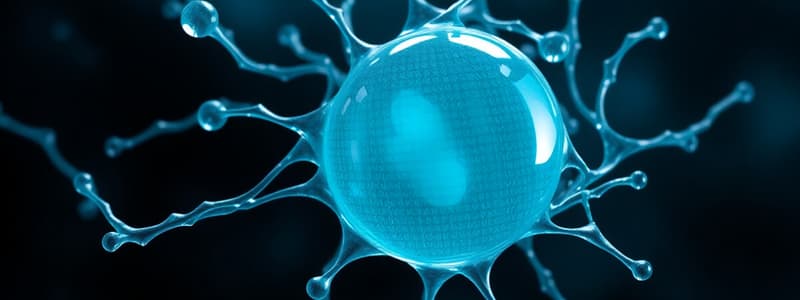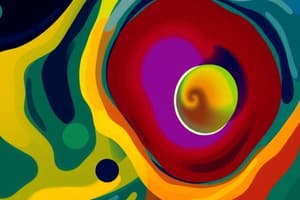Podcast
Questions and Answers
What structure is continuous with the outer layer of the nuclear envelope?
What structure is continuous with the outer layer of the nuclear envelope?
- Golgi apparatus
- Endoplasmic Reticulum (ER) (correct)
- Plasma membrane
- Nucleolus
Which of the following is NOT a function of the nucleus?
Which of the following is NOT a function of the nucleus?
- Storing genetic material
- Synthesizing phospholipids (correct)
- Instructing protein synthesis
- Directing metabolic activities
What characteristic of the plasma membrane allows certain substances to pass through while preventing others?
What characteristic of the plasma membrane allows certain substances to pass through while preventing others?
- Static composition
- Partially permeable (correct)
- Rigid structure
- Fully permeable
Which process involved in the function of the nucleus specifically relates to cell reproduction?
Which process involved in the function of the nucleus specifically relates to cell reproduction?
In relation to the nuclear envelope, what is true about the pores in the membrane?
In relation to the nuclear envelope, what is true about the pores in the membrane?
What is the primary role of the Golgi apparatus in an animal cell?
What is the primary role of the Golgi apparatus in an animal cell?
Which of the following is NOT a function of the Golgi apparatus?
Which of the following is NOT a function of the Golgi apparatus?
How many Golgi apparatuses are typically found in each animal cell?
How many Golgi apparatuses are typically found in each animal cell?
What are vesicles that pinch off from the Golgi apparatus primarily responsible for?
What are vesicles that pinch off from the Golgi apparatus primarily responsible for?
Which substance is specifically mentioned as being secreted by the Golgi apparatus?
Which substance is specifically mentioned as being secreted by the Golgi apparatus?
What is the primary function of lysosomes in a cell?
What is the primary function of lysosomes in a cell?
What structure in the centrosome is essential during cell division?
What structure in the centrosome is essential during cell division?
What is the composition of microfilaments?
What is the composition of microfilaments?
How do microtubules function within a cell?
How do microtubules function within a cell?
What process do lysosomes contribute to when a cell is damaged beyond repair?
What process do lysosomes contribute to when a cell is damaged beyond repair?
What is the diameter range of microfilaments?
What is the diameter range of microfilaments?
What role do centrioles play in cellular processes?
What role do centrioles play in cellular processes?
Which protein is primarily responsible for muscle contraction in association with microfilaments?
Which protein is primarily responsible for muscle contraction in association with microfilaments?
What is the primary function of mitochondria in cells?
What is the primary function of mitochondria in cells?
Which of the following statements is true about the Rough Endoplasmic Reticulum (RER)?
Which of the following statements is true about the Rough Endoplasmic Reticulum (RER)?
Which structural feature of mitochondria increases their surface area for chemical reactions?
Which structural feature of mitochondria increases their surface area for chemical reactions?
What is produced from the catabolism of carbohydrates, fats, and proteins in cells?
What is produced from the catabolism of carbohydrates, fats, and proteins in cells?
In which type of cells would you expect to find the greatest number of mitochondria?
In which type of cells would you expect to find the greatest number of mitochondria?
What is one of the key roles of the Rough Endoplasmic Reticulum besides protein production?
What is one of the key roles of the Rough Endoplasmic Reticulum besides protein production?
Which of the following materials is not typically stored in mitochondria?
Which of the following materials is not typically stored in mitochondria?
What type of cells would contain a significant amount of Smooth Endoplasmic Reticulum (SER)?
What type of cells would contain a significant amount of Smooth Endoplasmic Reticulum (SER)?
What is the main driving factor behind active transport?
What is the main driving factor behind active transport?
Which process is specifically responsible for the movement of water across a semi-permeable membrane?
Which process is specifically responsible for the movement of water across a semi-permeable membrane?
What distinguishes phagocytosis from pinocytosis?
What distinguishes phagocytosis from pinocytosis?
Which of the following is true about hyperplasia?
Which of the following is true about hyperplasia?
In which process do vesicles form to intake liquids into the cell?
In which process do vesicles form to intake liquids into the cell?
What happens during exocytosis?
What happens during exocytosis?
Which factor does not influence the rate of diffusion?
Which factor does not influence the rate of diffusion?
What is the primary role of the sodium-potassium pump in active transport?
What is the primary role of the sodium-potassium pump in active transport?
Flashcards
Nucleus
Nucleus
The largest organelle in a cell, enclosed by a double membrane, containing DNA and directing cell activities.
Plasma (Cell) Membrane
Plasma (Cell) Membrane
A partially permeable barrier made of two layers that surrounds the cell and is embedded with other substances (e.g. proteins, lipids).
Mitochondrion (Mitochondria)
Mitochondrion (Mitochondria)
The 'powerhouse of the cell'; an organelle with inner folded membranes (cristae) where cellular aerobic respiration and ATP production occur.
Rough Endoplasmic Reticulum (RER)
Rough Endoplasmic Reticulum (RER)
Signup and view all the flashcards
Smooth Endoplasmic Reticulum (SER)
Smooth Endoplasmic Reticulum (SER)
Signup and view all the flashcards
Golgi Apparatus
Golgi Apparatus
Signup and view all the flashcards
Lysosome
Lysosome
Signup and view all the flashcards
Centrosome
Centrosome
Signup and view all the flashcards
Microfilaments
Microfilaments
Signup and view all the flashcards
Microtubules
Microtubules
Signup and view all the flashcards
Diffusion
Diffusion
Signup and view all the flashcards
Osmosis
Osmosis
Signup and view all the flashcards
Active Transport
Active Transport
Signup and view all the flashcards
Phagocytosis
Phagocytosis
Signup and view all the flashcards
Pinocytosis
Pinocytosis
Signup and view all the flashcards
Hyperplasia
Hyperplasia
Signup and view all the flashcards
Study Notes
### The Nucleus
- The largest feature in a cell
- Bound by a double membrane, the nuclear envelope, with the outer layer being continuous with the Endoplasmic Reticulum (ER).
- Pores in the membrane allow the passage of substances.
- Stores genetic material (DNA).
- Directs all metabolic activities of the cell, including growth, metabolism, protein synthesis, and reproduction (cell division).
- Involved in cell division.
- Instructs the synthesis of proteins/ribosomes & RNA.
Plasma (Cell) Membrane
- Partially permeable.
- Made up of two layers.
- Embedded with proteins and Na, phosphates, chlorides, amino acids, ATP, and storage material (oil droplets).
Mitochondrion (Mitochondria)
- The ‘powerhouse of the cell.’
- Contains an outer and inner membrane.
- Cristae (folded inner membrane) allow maximum surface area for chemical reactions to occur.
- Involved with cellular aerobic (O2) respiration, the process by which chemical energy is made available in the cell.
- Energy = ATP (Adenosine triphosphate) is formed from the catabolism of carbohydrates, fats, and proteins in the cell.
- Occur in varying numbers depending on the cell and its function, with the greatest number in cells that are physically and metabolically active (e.g., skeletal muscles).
Rough Endoplasmic Reticulum (RER)
- A series of interconnecting membranous canals which enclose flattened sacs called cisternae.
- Covered in ribosomes which make proteins.
- An extension of the outer nuclear membrane.
- Has a large surface area for chemical reactions.
Function of the Rough Endoplasmic Reticulum (RER)
- Produces proteins, especially enzymes.
- Pathway for the transport of materials through the cell.
- Collecting and storing synthesized material.
- Providing a structural skeleton to maintain cellular shape.
Smooth Endoplasmic Reticulum (SER)
- Similar features to RER but with no ribosomes.
- Found in large amounts in cells which secrete steroids, such as the adrenal cortex in the kidney.
- Concerned with the synthesis of lipids and steroid hormones.
- Contains enzymes for detoxifying chemicals, including drugs and pesticides.
Golgi Apparatus
- Composed of stacks of flattened membranous sacs called cisternae.
- Sacs are fluid-filled and pinch off smaller membranous sacs, called vesicles.
- Normally, only one Golgi apparatus in each animal cell.
Function of the Golgi Apparatus
- Packages and processes proteins received from the ER into vesicles prior to secretion.
- Vesicles then deliver them to their destinations (e.g., lysosomes or the cell membrane).
- This plays a key role in the secretory pathway.
Golgi Apparatus Continued…
- Producing secretory enzymes (e.g., digestive enzymes).
- Transporting and storing lipids.
- Receiving glyco-proteins such as mucin required.
- Secreting carbohydrates.
- Forming lysosomes.
Lysosome and its Function
- A membrane-bound cell organelle that contains digestive enzymes.
- If a cell is damaged beyond repair, lysosomes can help it to self-destruct by apoptosis (programmed cell death).
- They destroy invading viruses and bacteria.
- They break down excess or worn-out cell parts.
- Help to break down food particles when cells engulf them.
Centrosome
- Directs the organization of microtubules within the cell.
- Comprises a pair of centrioles (small clusters of microtubules).
- Plays an important part during cell division.
### Centrosome
- Comprises two centrioles, cylindrical structures, orientated at right angles to each other.
- Act as organizers of the nuclear spindle during cell division.
### Microfilaments
- Fine, thread-like protein fibres, 3-6 nm in diameter.
- Composed predominantly of a contractile protein called actin, which is the most abundant cellular protein.
- Can also carry out cellular movements, including gliding, contraction, and cytokinesis (the division of cytoplasm following division of a nucleus).
- Association with the protein myosin is responsible for muscle contraction.
Microtubules
- Cylindrical tubes, 20-25nm in diameter.
- Involved in intracellular transport (e.g., diffusion, osmosis, active transport, phagocytosis, pinocytosis).
Diffusion
- The process by which a substance moves from a region of high concentration to a region of low concentration.
- The rate is variable and depends on the concentration gradient, distance, the size of the area, structure in the path, and the size of the molecule.
Osmosis
- The passage of water down its concentration gradient towards equilibrium across a semi-permanent membrane.
- Occurs when solute molecules are too large to pass through the pores in the membrane by diffusion.
Active Transport
- The transport of substances up their concentration gradient (i.e., from a lower to a higher concentration).
- Chemical energy (ATP) drives protein molecules in the membrane that transport substances across the membrane in either direction.
- E.g., the sodium-potassium pump maintains homeostasis of electrolytes sodium and potassium.
### Phagocytosis
- The process by which the cell can obtain particles which are too large to be absorbed by diffusion or active transport.
### Pinocytosis
- ‘Cell drinking’ is very similar to phagocytosis except vesicles are produced called 'pinocytotic vesicles.'
- Used for the intake of liquids rather than solids.
- Both pinocytosis and phagocytosis are methods by which materials are taken into the cell in bulk (endocytosis).
- The reverse process – materials are removed from the cell (e.g., waste products) – exocytosis.
Abnormal Cell Growth
- Hyperplasia: A term referring to the proliferation of cells within an organ or tissue beyond that which is ordinarily seen (i.e., constant cell division).
Studying That Suits You
Use AI to generate personalized quizzes and flashcards to suit your learning preferences.




